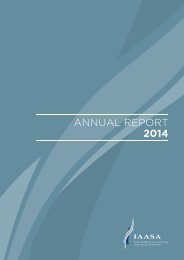Annual_Report2014
Create successful ePaper yourself
Turn your PDF publications into a flip-book with our unique Google optimized e-Paper software.
<strong>Annual</strong> Report 2014<br />
Irish Auditing & Accounting Supervisory Authority<br />
14<br />
Paragraph 31 of IFRS 7 requires that ‘An entity<br />
shall disclose information that enables users of its<br />
financial statements to evaluate the nature and<br />
extent of risks arising from financial instruments<br />
to which the entity is exposed at the end of the<br />
reporting period’.<br />
Paragraphs 33 and 34 of IFRS 7 require, for<br />
each type of risk, qualitative and quantitative<br />
disclosures including explanation for changes<br />
therein and require disclosures of concentrations<br />
of risk if not apparent from the disclosures.<br />
Paragraph 35 of IFRS 7 states that ‘If the<br />
quantitative data disclosed as at the end of the<br />
reporting period are unrepresentative of an entity’s<br />
exposure to risk during the period, an entity shall<br />
provide further information that is representative’.<br />
In deciding on the level of detail to present and<br />
how to aggregate information without combining<br />
information with different characteristics,<br />
paragraph B3 of IFRS 7 requires that ‘an entity<br />
shall not obscure important information by<br />
including it among a large amount of insignificant<br />
detail. Similarly, an entity shall not disclose<br />
information that is so aggregated that it obscures<br />
important differences between individual<br />
transactions or associated risks’.<br />
Paragraphs 112(c), 122 and 125 of IAS 1 Presentation<br />
of Financial Statements require disclosure of:<br />
(a) information that is not presented elsewhere in<br />
the financial statements but is relevant to an<br />
understanding of items;<br />
(b) the significant accounting policies and<br />
judgements that management has made in<br />
the process of applying policies; and<br />
(c) the sources of estimation uncertainty.<br />
Findings<br />
IAASA was concerned that the disclosure of<br />
forborne loans and forbearance measures in the<br />
financial statements of the financial institutions<br />
did not adequately reflect the risks arising from<br />
exposure to the forborne loan portfolio and the<br />
impact that forborne loans have on the institutions’<br />
financial performance, financial position and future<br />
cash flows.<br />
Following an examination of the forbearance<br />
disclosures of the main financial institutions that<br />
come within its supervisory remit (i.e. Allied Irish<br />
Banks plc, Bank of Ireland and Permanent TSB<br />
Group Holdings plc), IAASA was of the view that<br />
the disclosures provided in their annual reports<br />
did not comply in full with the relevant financial<br />
reporting standard. Those financial institutions<br />
were required to provide additional and more<br />
disaggregated forbearance disclosures and to<br />
include all the required disclosures on forborne<br />
loans within their future audited financial<br />
statements.<br />
IAASA’s view was that the granting of forbearance<br />
measures to selected borrowers, while not<br />
necessarily indicative of an impairment loss, was<br />
indicative of an elevated level of credit risk and<br />
the underlying financial stress amongst a material<br />
component of a financial institution’s borrowers.<br />
Loans that had been the subject of forbearance<br />
measures posed a more significant and elevated<br />
risk to the performance and financial position of<br />
the financial institution as opposed to the risks<br />
from non-forborne loans. The key performance<br />
metrics of forborne loans were likely to exhibit a<br />
higher probability of default, higher loan to value<br />
ratios and an elevated level of impairment charges<br />
and uncertain forecast cash flows. Therefore, more<br />
transparent disclosure of the significant levels<br />
of forborne loans and movements therein was<br />
considered necessary for an understanding of the<br />
institution’s performance, financial position and<br />
future cash flows.<br />
In addition, the disclosure of quantitative<br />
information of both forborne and non-forborne<br />
loans in aggregate (without appropriate<br />
segmentation of a type and level of detail applied<br />
to non-forborne loans) could inhibit the ability<br />
of users to understand the risk exposures and<br />
changes in those risks during the year that are<br />
associated with forborne loans. For example,<br />
whether the forbearance disclosures enable<br />
users to fully understand the significance of<br />
loans that are subject to forbearance measures,<br />
how successful or otherwise those forbearance<br />
measures are and their impact on the issuer’s<br />
financial performance, financial position and cash<br />
flows.



